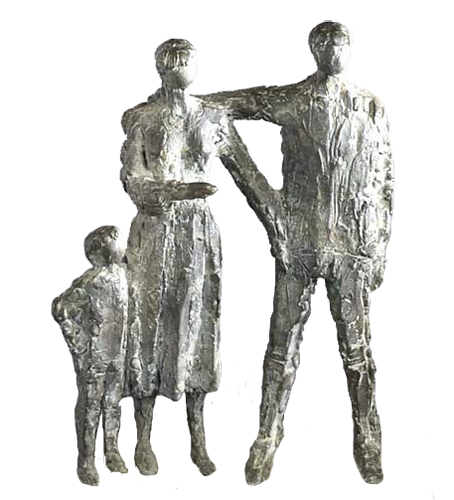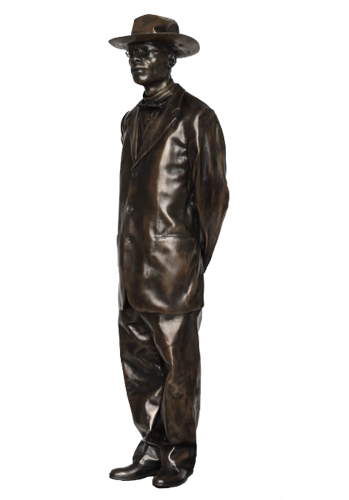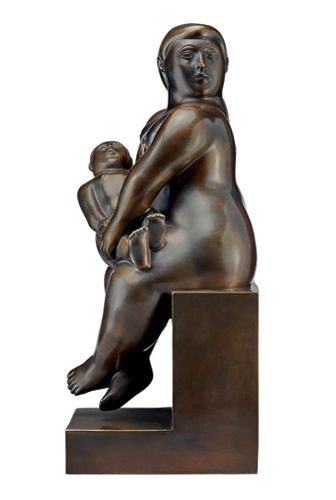 |
|
 |
 Ldamie as a Modern Artist
Ldamie as a Modern Artist
It can truly be said that Ldamie was a modern, modernist artist. A comparison with Irish sculptor, Melanie le Brocquy helps bring this notion to a fine point. In the obituary for Melanie le Brocquy Stewart (1919-2018), titled: "Modernist artist who captured the lives of ordinary people in ordinary situations," it is observed:
"Melanie le Brocquy's work is unmistakably modernist in its themes of picturing the lives of ordinary people in ordinary situations, or sometimes extraordinary people rendered in a very human style, .."
"Writing in this newspaper [The Irish Times] of [her] retrospective of 1999, Aidan Dunne described her sculpture as "subtle and understated; it ... is forthrightly domestic in scale, adding that: "while her figure studies are characterized by detailed observation, it is not observation in the academic sense of the exhaustive study of anatomical structure. With le Brocquy, it's more a question of noticing small gestures, momentary movements and attitudes, like vivid details glimpsed in the corner of your eye."
Melanie le Brocquy's work shows the touch of the palette knife, and her sculpture typically doesn't have the detail of facial features, but both le Brocquy and Ldamie work with abstraction, and depict the lives of ordinary people. And the figure studies of both artists: "are characterized by detailed observation."
Carrying the analogy yet further, both artists worked in multiples, as Warhol and other modern and contemporary artists did. Melanie le Brocquy, for example, "made a bust of Wilde, whom she admired, cast in a set of four, which are now in, respectively, the Irish embassy in Washington, Trinity
|
 |
 College, Dublin, Magdelen College, Oxford and the American College located in Wilde's childhood home..." Using sand casting methods, Ldamie did not have the benefit of molds that could be used multiple times, but he clearly worked in multiples, as will be seen later in these galleries.
College, Dublin, Magdelen College, Oxford and the American College located in Wilde's childhood home..." Using sand casting methods, Ldamie did not have the benefit of molds that could be used multiple times, but he clearly worked in multiples, as will be seen later in these galleries.
If only Ldamie and le Brocquy were compared, together with Malawian artist Samson Kambalu perhaps, Ldamie might be disqualified as a modern artist, in part because of the geometry of his sculpted surface (in contrast to le Brocquy and Kambalu) and the presence in his work of distinct features of the face, hands and feet (in contrast Henry Moore); yet modernist sculpture encompasses many styles, and the sculpture of Botero and Gustave Vigeland, seen further to the right, have just such smoothness of surface and figural detail.
In these many ways, the depiction of ordinary people, attention to detail, and working in multiples, Ldamie, like his European peers - le Brocquy, Vigeland and Botero - is a modern artist. I think it can be said that if transported to Europe in the years between 1920 and 1940, with the opportunity to work with modern tools, and with European, not African, subjects, Ldamie would be recognized as being in the forefront of the modernists. The scope and philosophy of their work is nearly the same. But living in Africa, and depicting the bodies and faces of Africans, I think it can also be fairly said that Ldamie was among Africa's first modern artists, breaking with tradition, and away from the mold of the spiritual shaman who communed with the spirits.
An objection to "elevating" the status of Ldamie to the rank of modern artist is the attribution of "primitivism," that Ldamie merely depicted backward, naked people running about in the jungle. But the photographs of Liberia taken by Walter Logan Fry in the years when Ldamie was working, in this case 1934-1935, clearly show that the people of Liberia did not, in fact,
|
 |
 run about naked, and none ever had their lower bodies exposed in public, while many dressed as modestly as the Amish (Ldamie included). Ldamie portrayed the nude, just as Europeans. from the Grecian era to the present, have done. Indeed, Michelangelo, in his masterwork David, depicted the nude as ostentatiously as was ever undertaken by Ldamie, so that only scale (small rather than monumental), material (bronze rather than marble), body proportions and facial characteristics (African rather than European) are different.
run about naked, and none ever had their lower bodies exposed in public, while many dressed as modestly as the Amish (Ldamie included). Ldamie portrayed the nude, just as Europeans. from the Grecian era to the present, have done. Indeed, Michelangelo, in his masterwork David, depicted the nude as ostentatiously as was ever undertaken by Ldamie, so that only scale (small rather than monumental), material (bronze rather than marble), body proportions and facial characteristics (African rather than European) are different.
The essay "Primitivism and Modern Art" by Dr. Charles Cramer and Dr. Kim Grant, begins with the following observation:
"Primitivism in art involves the appreciation and imitation of cultural products and practices perceived to be "primitive," or at an earlier stage of a supposed common scale of human development. This definition contains a basic contradiction: the primitive is admired and even seen as a model, but at the same it is also presumed to be inferior, because [their culture] is not fully developed. This paradox makes primitivism a concept that is both intellectually and morally complex."
Would "intellectually and morally corrupt" be a better way to put it?
If Ldamie was a modern artist in every other respect, then living in Africa at the time that he did, does not strip him of that status.
The following galleries demonstrate how Ldamie: 1) broke from tradition; 2) depicted the lives of ordinary people; 3) paid exquisite attention to detail; and 4) often worked in multiples. The final gallery, Ldamie Group N, debunks the theoretical basis of some woefully mistaken "African art experts," including some "esteemed" curators of African art, who call the work "tourist art."
But first, the comparisons to the work of other modern artists.
|
 |

Melanie le Brocquy
Ireland
family grouping
|
 |

Samson Kambalu
Malawi; UK
John Chilembwe
|
 |

Ldamie
Liberia
Fanga drummer
|
 |

Gustave Vigeland
Norway
standing woman
|
 |

Ldamie
Liberia
mother holding baby
|
 |

Botero
Colombia, USA
mother holding baby
|
 |
|